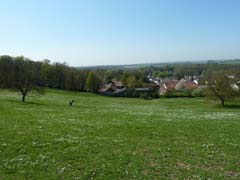Prochain point : lat="49.0798" lon="1.928640005"

Panorama from Jacquebot Cross
A village nestling among the vegetation
Nestled deep in the Aubette valley, the village of Vigny disappears among the vegetation. In the foreground, recent buildings bear witness to the extension of the heart of the village. Facing south, widespread suburban housing spreads up the hill, contrasting with the fabric of old buildings in the valley. The church of Saint-Médard is at the centre of the old, densely built area composed of terraced town houses, the homes of notables and small farms set out around two main streets. The remarkable château and parkland, marked out by the surrounding wall, represent a transition between the developed area and the agricultural valley.
The plateau to the far horizon
Orchards and fallow lands are located near the houses. In the background you can see the agricultural limestone plateau, the large grain-growing area. The view to the southwest is very open, lightly scattered with patches of woods.
Vigny-Longuesse quarry :
a unique geological site and a natural environment of great diversity
This site of 21.8 hectares, straddling the towns of Vigny and Longuesse, belongs to the General Council of Val d'Oise. The stone was excavated traditionally as an open pit from the eighteenth century, and industrially from 1920 until 2001. Vigny stone was notably used to restore historical monuments (La Roche-Guyon château, the church of Saint-Martin-la-Garenne), to renovate the Paris sewers and to build roads. It was also sold privately or exported to Holland.
The quarry is like an open-air museum, where it is possible to visualize the geological history of the Paris Basin during the transition between the secondary and tertiary eras (65 million years ago). It is a very rich site with nearly 350 fossil species (algae, corals, molluscs) recorded here. It is internationally known for tectonic movements and events (overlapping layers from two eras) making it a geological exception. The site is home to 354 plant species, 26 species of butterflies and 48 species of birds. It is now preserved and restored thanks to its classification as a departmental sensitive natural area and as a regional nature reserve.






